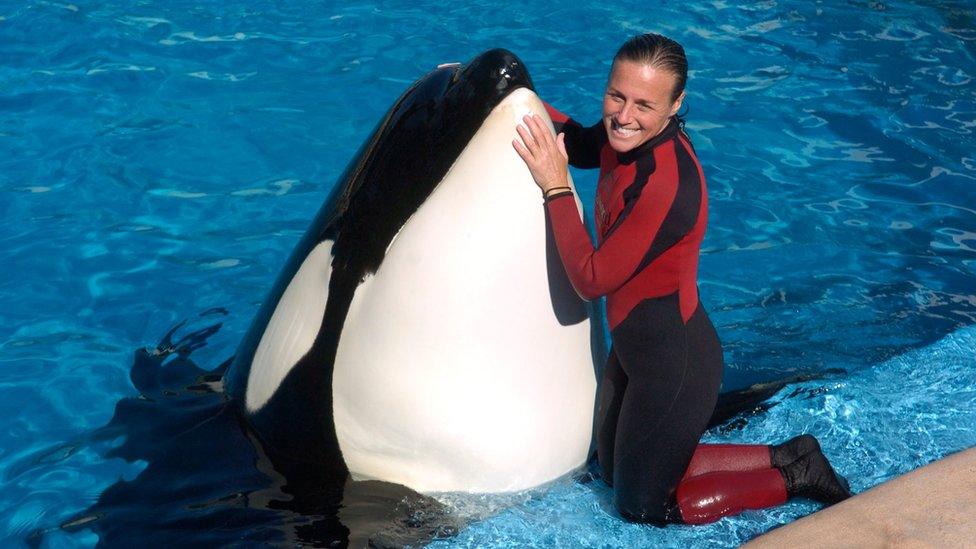The Truth Behind the “Orca Attack on Jessica Radcliffe” Video
In recent days, social media has been flooded with a shocking video purporting to show a marine trainer named Jessica Radcliffe being savagely attacked by an orca during a live performance. The footage is graphic and intense: panicked screams, splashing water, and the sight of an orca dragging the woman into the water with brutal force. Many who viewed the video expressed outrage, sadness, and renewed their calls for an end to marine animal shows.
But behind the disturbing images lies a very different reality: the event never happened.
1. Viral video, fictional event
Generated image
Fact-checkers have confirmed that there are no records of a marine trainer named Jessica Radcliffe at any professional marine park or orca facility. There are also no official reports of such an attack. The video was generated using advanced artificial intelligence (AI) techniques, combining realistic animation with synthetic audio to simulate a real tragedy.
The video’s creators used quick cuts, dramatic sound effects, and carefully staged visuals to amplify the emotional impact. To the untrained eye, the footage appears authentic, which is why it spread so quickly.
2. Why it spread so quickly
Three main factors drove the virality of this fake video:
Emotional shock factor. Content that provokes a strong emotional reaction (fear, anger, compassion) overcomes our logical filters. In moments of shock, the human brain is less likely to question authenticity, making viewers more likely to share without verification.
Plausible context. Orcas have a well-documented history of dangerous behavior in captivity. Past tragedies, such as the deaths of trainers Dawn Brancheau at SeaWorld in 2010 and Alexis Martínez in Spain in 2009, remain etched in the public memory. This history made the fabricated scenario seem credible.
Technological sophistication. Modern AI can now replicate human-like facial expressions, lighting, water effects, and even movements with alarming realism. For most viewers, distinguishing an AI-generated video from a genuine recording is nearly impossible without specialized tools.
Orcas swim in a tank at SeaWorld in San Diego, California, on Wednesday, July 17, 2013. (Photo by Sandy Huffaker/Corbis via Getty Images)
3. Signs it’s fake
While convincing, the video contains subtle clues that betray its artificial origin:
Slightly unnatural movements: Certain frames show distortions, especially in small details such as hands, hair, or water splashes.
Strange audio timing: Screams and water noises sometimes don’t match up perfectly with the visuals.
Lack of credible coverage: A fatal orca attack during a public performance would be global news, but no reputable media outlet reported it.
4. The most important warning
: The “Jessica Radcliffe” hoax is a clear example of how AI-generated content can exploit our emotions and erode trust in visual media. In the digital age, seeing is not believing, and this should be deeply concerning to anyone who consumes news online.
Some practical measures to protect yourself against this type of scam include:
Verify the source. Reliable media outlets will report on important events. If the story only exists in viral videos and social media posts, be skeptical.
Use reverse image or video search tools. These can reveal whether the same material appeared elsewhere or in a different context.
Stop when emotions get out of hand. If a clip instantly triggers strong emotions, take a moment to check it before reacting or sharing it.
5. Lasting Impact
In addition to misleading viewers, fabricated videos like this can damage reputations and spark public outrage based on falsehoods. In this case, there is a risk of unfairly damaging the credibility of marine parks and trainers, who are already facing intense scrutiny.
It also underscores the need for platforms and regulators to develop detection systems capable of identifying deepfake and AI-generated content before it goes viral. At the same time, public media literacy education is essential, as even the most advanced detection systems cannot protect us if, as individuals, we don’t question what we see.
Tilikum, the SeaWorld orca who killed his trainer, dies – BBC News
The “Jessica Radcliffe” video also reopens the debate about the ethics of keeping large, intelligent marine animals in captivity. While the attack itself is fictional, it draws on real debates about animal welfare, safety, and the responsibilities of entertainment establishments. By exploiting this emotional context, the creators ensured maximum engagement, but at the expense of authenticity.
Conclusion: 
The “Jessica Radcliffe killer whale attack” never happened. It is a product of artificial intelligence designed to look real, leveraging emotional triggers and a believable story to deceive viewers. In the age of AI, authenticity is no longer guaranteed by sight alone. The lesson is clear: question what you see, verify before you believe, and remember that in today’s digital world,






